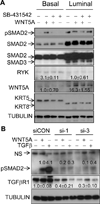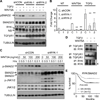Paracrine WNT5A Signaling Inhibits Expansion of Tumor-Initiating Cells
- PMID: 25769722
- PMCID: PMC4433621
- DOI: 10.1158/0008-5472.CAN-14-2761
Paracrine WNT5A Signaling Inhibits Expansion of Tumor-Initiating Cells
Abstract
It is not well understood how paracrine communication between basal and luminal cell populations in the mammary gland affects tumorigenesis. During ErbB2-induced mammary tumorigenesis, enriched mammary stem cells that represent a subpopulation of basal cells exhibit enhanced tumorigenic capacity compared with the corresponding luminal progenitors. Transcript profiling of tumors derived from basal and luminal tumor-initiating cells (TIC) revealed preferential loss of the noncanonical Wnt ligand WNT5A in basal TIC-derived tumors. Heterozygous loss of WNT5A was correlated with shorter survival of breast cancer patients. In a mouse model of ErbB2-induced breast cancer, Wnt5a heterozygosity promoted tumor multiplicity and pulmonary metastasis. As a TGFβ substrate, luminal cell-produced WNT5A induced a feed-forward loop to activate SMAD2 in a RYK and TGFβR1-dependent manner to limit the expansion of basal TIC in a paracrine fashion, a potential explanation for the suppressive effect of WNT5A in mammary tumorigenesis. Our results identify the WNT5A/RYK module as a spatial regulator of the TGFβ-SMAD signaling pathway in the context of mammary gland development and carcinogenesis, offering a new perspective on tumor suppression provided by basal-luminal cross-talk in normal mammary tissue.
©2015 American Association for Cancer Research.
Conflict of interest statement
All authors possess no conflicts of interest.
Figures







Similar articles
-
Paracrine WNT5A signaling in healthy and neoplastic mammary tissue.Mol Cell Oncol. 2015 Jul 28;3(1):e1040145. doi: 10.1080/23723556.2015.1040145. eCollection 2016 Jan. Mol Cell Oncol. 2015. PMID: 27308558 Free PMC article.
-
Wnt5a as an effector of TGFβ in mammary development and cancer.J Mammary Gland Biol Neoplasia. 2011 Jun;16(2):157-67. doi: 10.1007/s10911-011-9205-5. Epub 2011 Mar 18. J Mammary Gland Biol Neoplasia. 2011. PMID: 21416313 Free PMC article. Review.
-
Activation of noncanonical Wnt signaling through WNT5A in visceral adipose tissue of obese subjects is related to inflammation.J Clin Endocrinol Metab. 2014 Aug;99(8):E1407-17. doi: 10.1210/jc.2014-1191. Epub 2014 May 19. J Clin Endocrinol Metab. 2014. PMID: 24840810
-
Wnt5a suppresses tumor formation and redirects tumor phenotype in MMTV-Wnt1 tumors.PLoS One. 2014 Nov 17;9(11):e113247. doi: 10.1371/journal.pone.0113247. eCollection 2014. PLoS One. 2014. PMID: 25401739 Free PMC article.
-
Cell/tissue-tropic functions of Wnt5a signaling in normal and cancer cells.Trends Cell Biol. 2010 Jun;20(6):346-54. doi: 10.1016/j.tcb.2010.03.001. Epub 2010 Mar 30. Trends Cell Biol. 2010. PMID: 20359892 Review.
Cited by
-
Frizzled Receptors in Tumors, Focusing on Signaling, Roles, Modulation Mechanisms, and Targeted Therapies.Oncol Res. 2021 Mar 16;28(6):661-674. doi: 10.3727/096504020X16014648664459. Epub 2020 Sep 30. Oncol Res. 2021. PMID: 32998794 Free PMC article. Review.
-
E2F1-mediated repression of WNT5A expression promotes brain metastasis dependent on the ERK1/2 pathway in EGFR-mutant non-small cell lung cancer.Cell Mol Life Sci. 2021 Mar;78(6):2877-2891. doi: 10.1007/s00018-020-03678-6. Epub 2020 Oct 19. Cell Mol Life Sci. 2021. PMID: 33078208 Free PMC article.
-
Obesity-associated NLRC4 inflammasome activation drives breast cancer progression.Nat Commun. 2016 Oct 6;7:13007. doi: 10.1038/ncomms13007. Nat Commun. 2016. PMID: 27708283 Free PMC article.
-
Noncanonical WNT5A controls the activation of latent TGF-β to drive fibroblast activation and tissue fibrosis.J Clin Invest. 2024 Mar 26;134(10):e159884. doi: 10.1172/JCI159884. J Clin Invest. 2024. PMID: 38747285 Free PMC article.
-
The Wnt Signalling Pathway: A Tailored Target in Cancer.Int J Mol Sci. 2020 Oct 18;21(20):7697. doi: 10.3390/ijms21207697. Int J Mol Sci. 2020. PMID: 33080952 Free PMC article. Review.
References
-
- Taipale J, Beachy PA. The Hedgehog and Wnt signalling pathways in cancer. Nature. 2001;411(6835):349–354. - PubMed
-
- Wansleeben C, Meijlink F. The planar cell polarity pathway in vertebrate development. Developmental Dynamics. 2011;240(3):616–626. - PubMed
-
- Slusarski DC, Yang-Snyder J, Busa WB, Moon RT. Modulation of Embryonic Intracellular Ca2+Signaling byWnt-5A. Developmental Biology. 1997;182(1):114–120. - PubMed
Publication types
MeSH terms
Substances
Grants and funding
LinkOut - more resources
Full Text Sources
Other Literature Sources
Medical
Molecular Biology Databases
Research Materials
Miscellaneous

